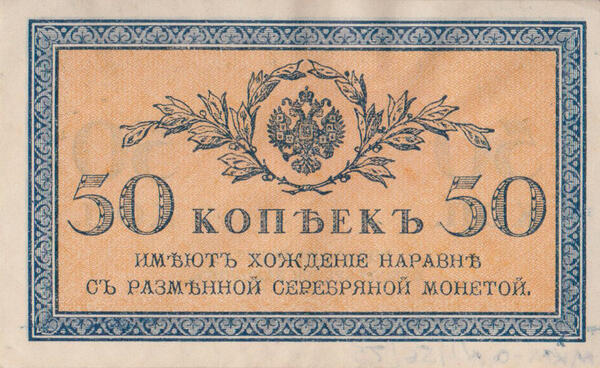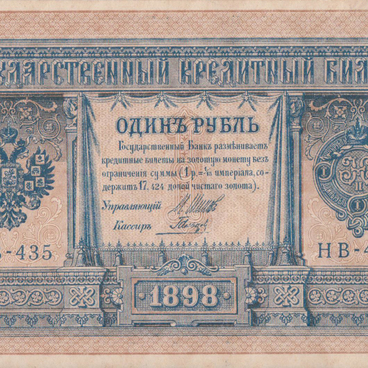The financial system established by Sergei Witte showed its high stability during the Russo-Japanese War and the 1905–1907 revolution. However, Russia’s entry into the First World War led to the system, which was based on exchanging money for gold, being abandoned. The decree of July 27, 1914 prohibited that operation because of wartime. The state needed money for the war. Banknotes not backed by gold began to be issued. All this led to inflation and a sharp decline in the value of banknotes. The state was also soon faced with a shortage of small change. The issue of money stamps failed to solve this problem, so in 1915 the State Paper Purchase Expedition was instructed to start issuing treasury notes in small denominations of 1 to 50 kopecks.
Unlike the stamp money, treasury notes were printed on watermarked paper. All of them had a very simple and uniform design that allowed them to be issued in large quantities at once. Treasury notes, including the 50 kopecks one presented in the Museum, were more convenient for everyday payments than banknotes, which is why the issue of the latter was reduced. However, the popularity of paper money and inflation during the war led to coins being almost completely withdrawn from circulation. The reason for this was the quite serious changes which took place in the economic life of the country. The economy showed high growth, but it was connected with the development of military sectors which worked for the front and brought considerable increase. The situation of food supply in the country was not critical either. Because of a sharp decrease in the volume of bread exported abroad, huge quantities of this commodity remained on the domestic market. There was therefore theoretically enough food for everyone. At the same time, there was a certain decline in industries not directly connected to the war. Difficulties in communication and delivery of supplies to different parts of the country meant that food shortages were rampant in some of them. The government tried to address this issue through the introduction of “prodrazvyorstka” — a system of agricultural produce procurement. But this was only a short-term success and did not lead to a solution to the problem. Because of all these factors, the population was keen to keep the coins, giving away increasingly devalued notes to the treasury.
Unlike the stamp money, treasury notes were printed on watermarked paper. All of them had a very simple and uniform design that allowed them to be issued in large quantities at once. Treasury notes, including the 50 kopecks one presented in the Museum, were more convenient for everyday payments than banknotes, which is why the issue of the latter was reduced. However, the popularity of paper money and inflation during the war led to coins being almost completely withdrawn from circulation. The reason for this was the quite serious changes which took place in the economic life of the country. The economy showed high growth, but it was connected with the development of military sectors which worked for the front and brought considerable increase. The situation of food supply in the country was not critical either. Because of a sharp decrease in the volume of bread exported abroad, huge quantities of this commodity remained on the domestic market. There was therefore theoretically enough food for everyone. At the same time, there was a certain decline in industries not directly connected to the war. Difficulties in communication and delivery of supplies to different parts of the country meant that food shortages were rampant in some of them. The government tried to address this issue through the introduction of “prodrazvyorstka” — a system of agricultural produce procurement. But this was only a short-term success and did not lead to a solution to the problem. Because of all these factors, the population was keen to keep the coins, giving away increasingly devalued notes to the treasury.



